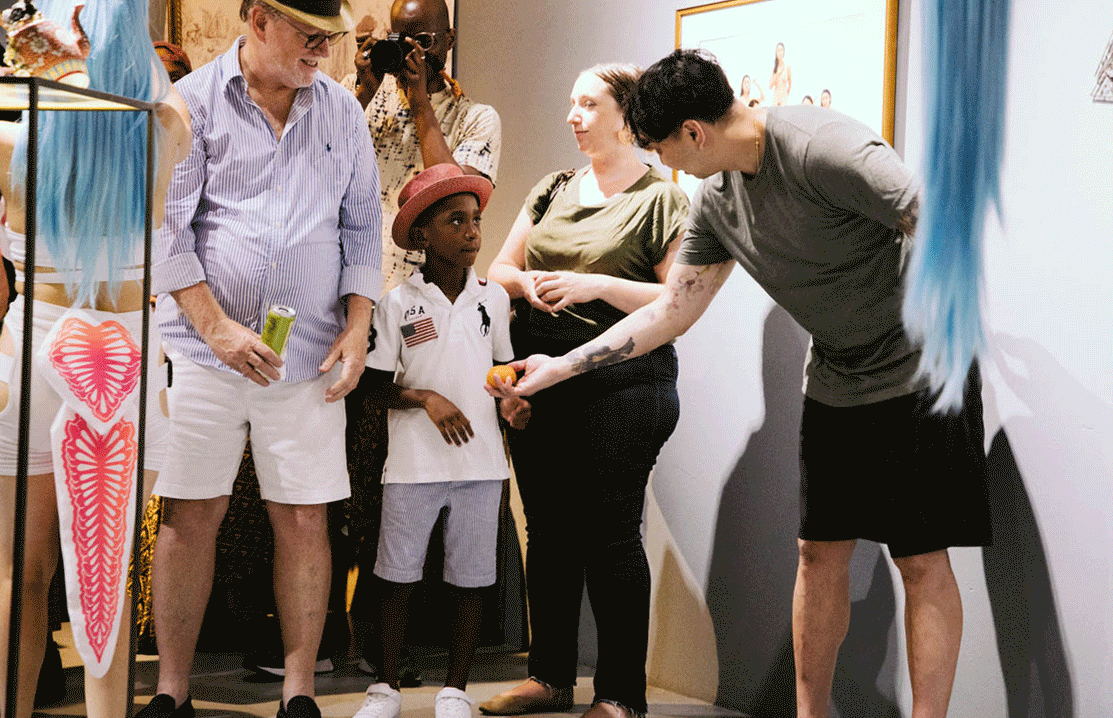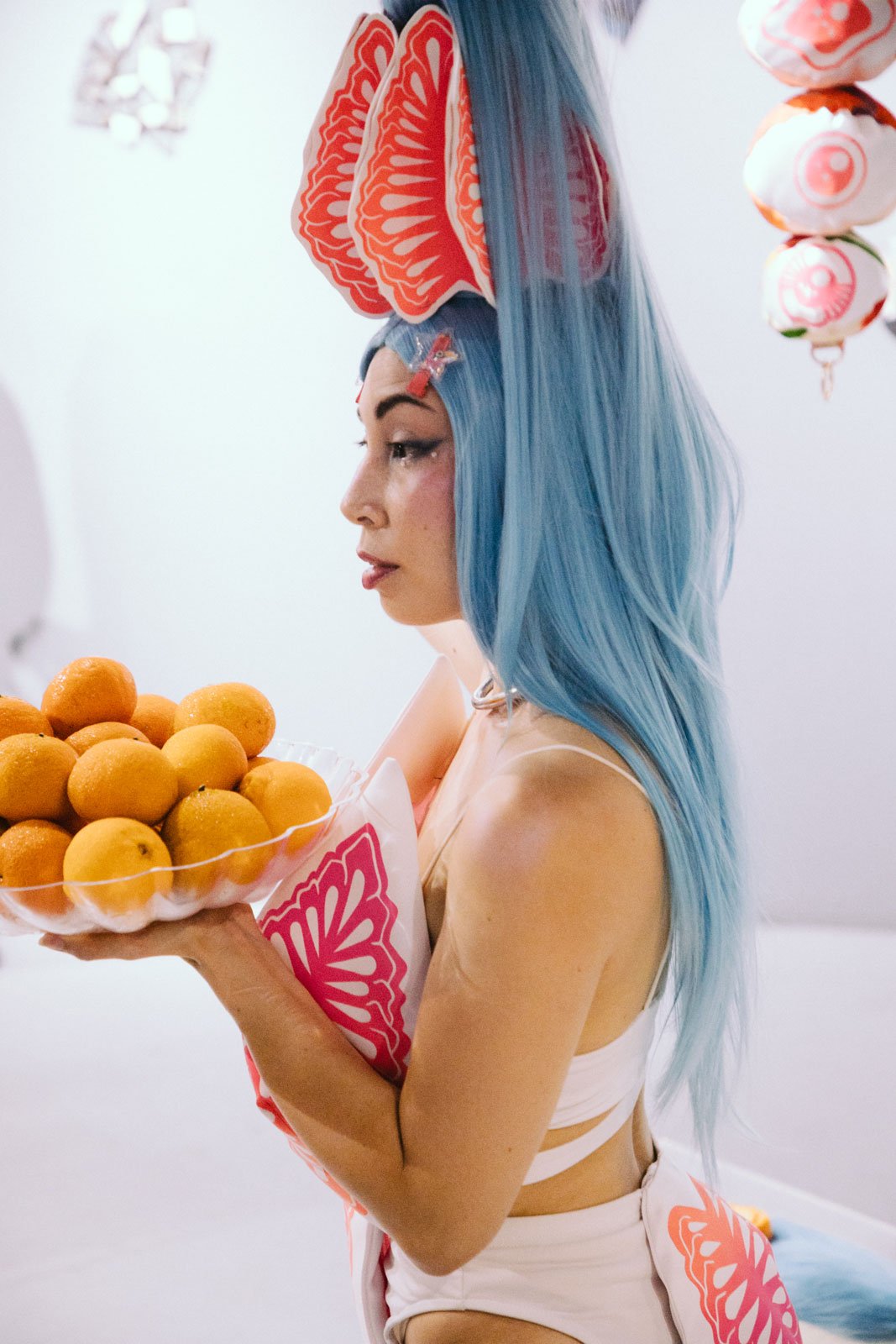Chanel Matsunami Govreau: Reanimating Queer Ancestry With Performance (CO)
“Have you ever heard the tale of the double-mouthed woman? I fucking love this story. It haunts and delights me,” Chanel Matsunami Govreau (she/they) stops for a laugh while retelling the story of Futakuchi Onna, an old Japanese folk tale about a femme monster that only eats through a voracious mouth hidden on the back of her head.
Just a couple of days prior to our conversation, Chanel intertwined a few Japanese folk tales, including Futakuchi Onna, into her live performance titled Tether Us (To Devour in Peace). The 15-minute piece took place during the opening night of Gathering, an exhibition curated by Sophia Ma and Cecile Chong that featured the works of 33 Asianish artists at FiveMyles, in Crown Heights, Brooklyn. Chanel is a mixed-race, pansexual, genderfluid, queer, Asian American artist. Their work is a blend of installation, screen printing, photography, and performance. Chanel’s aesthetics are strongly influenced by their Japanese heritage on their mother’s side. According to her artist statement, she uses fantasy and costume to build worlds where folks with intersectional identities, like herself, can exist with infinite belonging and engage in radical play.
“There's so much freedom in being the villain. You can follow your impulses and desires unapologetically.”
Chanel is attracted to villains and horror. A lot of her performance work features Japanese folkloric monsters and spirits known as yokai. “There's so much freedom in being the villain. You can follow your impulses and desires unapologetically. I think a lot of queer people can relate to that. We also follow our impulses, desires, and expressions of love, and we too are vilified for that,” says Chanel. She also uses folklore to address gender expansiveness: “A lot of creatures in Japanese folklore are shape shifters with hidden identities. I interpret this as an allegory for trans and non-binary identity and find power in these stories as a genderfluid person.”
Chanel detaches herself from the textile sculpture inspired by a hundred-eyed Japanese yokai monster called hyakume.
At the FiveMyles, Chanel begins their performance as Futakuchi Onna by gliding out onto the space with their hands above their head. Their head is adorned with a sculptural crown of Barbie-pink flower petals. Upon closer observation, the crown is patterned with sharp teeth and resembles a carnivorous plant. Her fingers are delicately curled up; it’s easy to glimpse a dance background in her strides and movements. She circles an acrylic table representing an altar with a set of three textile sculptures suspended over it. The sculptures represent another Japanese yokai—a hundred-eyed monster called hyakume. The soft sculpture consists of a multitude of spherical pink eyeballs of various sizes, cascading down in three trident-like rows. At the end of each row, a piece of synthetic blue hair is attached.
Chanel proceeds to caress each trident of hairy eyeballs with such tenderness and care that it reminds me of the relationship between the Na’vi people and the Tree of Souls in Avatar (Chanel dislikes this comparison because she feels that Avatar appropriates indigenous cultures). Surely enough, Chanel takes a seat at the altar, removes the synthetic hairpiece from the middle end of the sculpture, puts said piece on the altar, and then attaches the sculpture to her own hair. She then picks up a mandarin orange from a large plate filled with many more oranges and starts slowly, very slowly, peeling it to an audio recording of the Futakuchi Onna folk tale.
After taking her time to devour the mandarin, Chanel grabs the large plate filled with oranges and announces that she’d like to share. She explains to the audience, “If you receive an orange, you have three choices: eat, give, or offer. You can either eat the orange yourself, give it to another person of your choosing, or offer it upon the altar.” During the performance at FiveMyles, most audience members were very respectful and waited for Chanel to offer them the oranges before taking them.
However, during previous iterations of this performance, folks have reached into the bowl to fish out an orange for themselves. Chanel admits that such behavior during the performance surprises her, “I am kind of shocked at how grabby some people are. I think it might be cultural differences. To me, if you're grabbing the fruit, you might be stealing from an ancestor. I'm embodying an ancestral spirit and selecting people purely on impulse. If you're grabbing it off that plate, it's like you're stealing fruit from the altar. I don't know what kind of karmic energy that is gonna bring.”
“A lot of creatures in Japanese folklore are shape shifters with hidden identities. I interpret this as an allegory for trans and non-binary identity and find power in these stories as a genderfluid person.”
While the use of synthetic hair and sculptural crown of sharp teeth served as a connection to the story of Futakuchi Onna and the spiritual world of Chanel’s ancestry, the use of oranges deserves a bit more of an exploration.
Chanel explains that in a lot of East Asian cultures, mandarin oranges, called mikan in Japanese, are a gift commonly exchanged between friends, family, and neighbors. During the New Year’s season in Japan, it's a tradition to sit around the table with family and eat mikan together. “In this performance, I imagine how I might gather with my ancestors to share the fruit. I use my hair and sculptures to physically tether into an ancestral realm and become a living altar. I ask my body to become a portal so we can eat together again. I offer my mouth to the spirits to devour through me.”
Boy refuses an orange from a stranger LOL
During this performance, she uses orange peeling as a meditative moment to reconnect to her ancestors. “When I peel the fruit, I reconnect to the ancestors that I'm carrying in my head. Here I become a living extension of an altar. The performance is an attempt to embody, resurrect, or reanimate an ancestor. I think of folklore as a fantastical biography of these ancestors. The lost femmes and queer folks that were villainized and penned into folkloric horror as evil spirits. I desire to transform and reanimate them in the performance.”
“I think a lot about the lineage of queer people, like myself, that won’t have children. I wonder how our legacies will live on.”
Ancestry is a common throughline in Chanel’s work. She credits her ballroom mother Aishah Murray, aka Spyder, as a source of spiritual inspiration. Spyder is a legendary performer in the global ballroom community and former mother of the NYC chapter of the Iconic House of Ninja. The first time they met, Spyder gave Chanel a spiritual reading. “We met at a bakery in Chelsea. After chatting about ballroom, art, and our shared love of Janet Jackson, Spyder suddenly had a vision. She told me that my ancestors were present. She told me that they were peering over the edge of my existence watching over me with joy and adoration.”
This moment with Spyder partially inspired Chanel’s sculptural installation They Watch You Thrive—the hanging eyeball installation used during their Tether Us (to Devour in Peace) performance. “I am not active in ballroom anymore, but that was a very colorful, influential, and informative experience in my life. The people I met in ballroom became my chosen family, but also my chosen ancestors. So let's say when you join the House of Ninja, who are your ancestors? Sandy Appolonia Ninja, and Willi Ninja—the founding Mother and Father of the house. We lost them, and so many queer ancestors before their time; although you’ve never met them, you walk in their name and you try to honor their legacy.”
Chanel also receives reiki sessions at Minka, which is owned by Aki Baker, a Japanese healer, reiki practitioner, activist, and community organizer. “Aki was the first healing practitioner I worked with that was also Japanese,” says Chanel, “and in those sessions, Aki encourages us to call in all the ancestors that wanna be with us, that wanna be helpful to us. That was really hard for me. As a mixed person, I have white racist ancestors that I know do not want to be helpful to me as a Japanese American person. But by overcoming my spiritual blockages, I was able to meet these distant ancestors that continue to help me. During meditative journeys I can feel and see their faces, they’re not me, but it is me at the same time. I wonder, is this ancestor from the future or the past? I think a lot about the lineage of queer people, like myself, that won’t have children. I wonder how our legacies will live on. I also think about becoming lost to history or forgotten about. By reanimating my lost ancestors in performance, I want to disrupt the spiritual timelines separating us. I want to remember us all, even if for a brief moment.”
Explore more of Chanel’s work at chanelmatsunami.art or @chanelmatsunami on Instagram.









